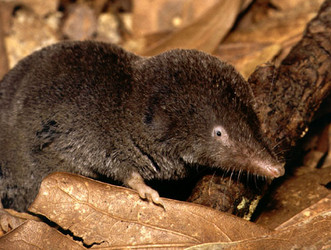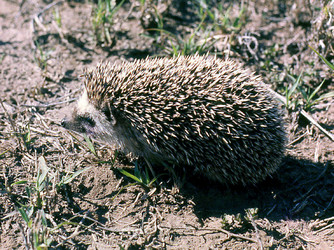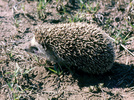Insectivora
- Erinaceidae (gymnures and hedgehogs)
- Solenodontidae (solenodons)
- Soricidae (shrews)
- Tenrecidae (tenrecs, Madagascar "hedgehogs")
- Talpidae (moles, shrew moles, desmans)
- Chrysochloridae (golden moles) (incertae sedis)
- Adapisoriculidae

- Sespedectidae

- Amphilemuridae

- Adapisoricidae

- Creotarsidae

- Proscalopidae

- Dimylidae

- Otlestidae

- Geolabididae

- Nesophontidae
 (West Indian shrews)
(West Indian shrews) - Micropternodontidae

- Apternodontidae

- Plesiosoricidae

- Nyctitheriidae

References
Asher, R. J. 1999. A morphological basis for assessing the phylogeny of the "Tenrecoidea" (Mammalia, Lipotyphla). Cladistics 15:231-252.
Asher, R. J. 2001. Cranial anatomy in tenrecid insectivorans: Character evolution across competing phylogenies. American Museum Novitates 3352:1–53.
Asher, R. J. 2005. Insectivoran-grade placental mammals: Character evolution andfossil history. Pages 50–70 in The Rise of Placental Mammals: Origin and Relationships of the Major Clades. K. D. Rose and J. D. Archibald, eds. Johns Hopkins University Press, Baltimore.
Asher, R. J. , R. J. Emry, and M. C. McKenna. 2005. New material of Centetodon (Mammalia, Lipotyphla) and the importance of (missing) DNA sequences in systematic paleontology. Journal of Vertebrate Paleontology 25(4):911-923.
Barton, R. A., A. Purvis, and P. H. Harvey. 1995. Evolutionary radiation of visual and olfactory brain systems in primates, bats and insectivores. Philosophical Transactions of the Royal Society of London Series B 348:381-392.
Butler, P. M. 1988. Phylogeny of the insectivores. Pages 117-141 in The Phylogeny and Classification of the Tetrapods. Volume 2: Mammals. (M. J. Benton, ed.) Clarendon Press, Oxford.
Churchfield, S. 1990. The Natural History of Shrews. Cornell University Press, Ithaca.
Corbet G. B. 1988. The family Erinaceidae - a synthesis of its taxonomy, phylogeny, ecology and zoogeography. Mammal Review 18:117-172.
Douady, C. J., F. Catzeflis, D. J. Kao, M. S. Springer, and M. J. Stanhope. 2002. Molecular evidence for the monophyly of tenrecidae (mammalia) and the timing of the colonization of Madagascar by Malagasy tenrecs. Molecular Phylogenetics and Evolution 22:357-363.
Douady, C. J., P. I. Chatelier, O. Madsen, W. W. de Jong, F. Catzeflis, M. S. Springer, and M. J. Stanhope. 2002. Molecular phylogenetic evidence confirming the Eulipotyphla concept and in support of hedgehogs as the sister group to shrews. Molecular Phylogenetics and Evolution 25(1):200-209.
Douady, C. J. and E. J. P. Douzery. 2003. Molecular estimation of eulipotyphlan divergence times and the evolution of "Insectivora". Molecular Phylogenetics and Evolution 28(2):285-296.
Emerson, G. L., C. W. Kilpatrick, B. E. McNiff, J. Ottenwalder, and M. W. Allard. 1999. Phylogenetic relationships of the order insectivora based on complete 12S rRNA sequences from mitochondria. Cladistics 15:221-230.
Frost, D. R., W. C. Wozencraft, and R. S. Hoffman. 1991. Phylogenetic relationships of hedgehogs and gymnures (Mammalia: Insectivora: Erinaceidae). Smithsonian Contributions to Zoology 518:1-69.
Fumagalli, L., P. Taberlet, D. T. Stewart, L. Gielly, J. Hausser, and P. Vogel. 1999. Molecular phylogeny and evolution of Sorex shrews (Soricidae : Insectivora) inferred from mitochondrial DNA sequence data. Molecular Phylogenetics and Evolution 11:222-235.
Gorman, M. L., and R. D. Stone. 1990. The Natural History of Moles. Cornell University Press, Ithaca.
Gould, G. C. 1995. Hedgehog phylogeny (Mammalia, Erinaceidae)--The reciprocal illumination of the quick and the dead. American Museum Novitates 3131:1-45.
Krettek, A., A. Gullberg, and U. Arnason. 1995. Sequence analysis of the complete mitochondrial DNA molecule of the hedgehog, Erinaceus europaeus, and the phylogenetic position of the Lipotyphla. Journal of Molecular Evolution 41:952-957.
Lopez-Fuster, M. J. and J. Ventura. 1997. Anatomical study of the abdominal arterial system in soricids (Insectivora, mammalia): Functional and phylogenetic implications. Anatomical Record 248:142-147.
MacPhee, R. D. E. and M. J. Novacek. 1993. Definition and relationships of Lipotyphla. Pages 13-31 in Mammal Phylogeny. Volume 2. Placentals. (F. S. Szalay, M. J. Novacek, and M. C. Mc Kenna, eds.) Springer Verlag, New York.
McKenna, M. C. and S. K. Bell. 1997. Classification of Mammals Above the Species Level. Columbia University Press, New York.
Merritt, J. F., G. L. Kirkland, Jr., and R. K. Rose (eds.) 1994. Advances in the Biology of Shrews. Special Publication 18. Carnegie Museum of Natural History, Pittsburgh.
Mouchaty, S. K., A. Gullberg, A. Janke, and U. Arnason. 2000. The phylogenetic position of the Talpidae within eutheria based on analysis of complete mitochondrial sequences. Molecular Biology and Evolution 17:60-67.
Nikaido, M., Y. Cao, M. Harada, N. Okada and M. Hasegawa. 2003. Mitochondrial phylogeny of hedgehogs and monophyly of Eulipotyphla. Molecular Phylogenetics and Evolution 28(2):276-284.
Nowak, R.M. 1999. Order Insectivora. Pages 169-243 in: Walker's Mammals of the World. Sixth Edition. Volume I. Johns Hopkins University Press, Baltimore.
Ohdachi, S., R. Masuda, H. Abe, J. Adachi, N. E. Dokuchaev, V. Haukisalmi, and M. C. Yoshida. 1997. Phylogeny of Eurasian soricine shrews (Insectivora, Mammalia) inferred from the mitochondrial cytochrome b gene sequences. Zoological Science 14:527-532.
Roca, A. L., G. K. Bar-Gal, E. Eizirik, K. M. Helgen, R. Maria, M. S. Springer, S. J. O'Brien, and W. J. Murphy. 2004. Mesozoic origin for West Indian insectivores. Nature 429(6992):649-651.
Reeve, N. 1994. Hedgehogs. T & AD Poyser Ltd., London.
Seiffert, E. R. and E. L. Simons. 2000. Widanelfarasia, a diminutive placental from the late Eocene of Egypt. Proceedings of the National Academy of Sciences (USA) 97:2646-2651.
Springer, M. S., G. C. Cleven, O. Madsen, W. W. de Jong, V. G. Waddell, H. M. Amrine, and M. J. Stanhope. 1997. Endemic African mammals shake the phylogenetic tree. Nature 388:61-64.
Stanhope M. J., V. G. Waddell, O. Madsen, W. W. de Jong, S. B. Hedges, G. C. Cleven, D. Kao, and M. S. Springer. 1998. Highly congruent molecular support for a diverse superordinal clade of endemic African mammals. Molecular Phylogenetics and Evolution 9:501-508.
Stanhope M. J., V. G. Waddell, O. Madsen, W. W. de Jong, S. B. Hedges, G. C. Cleven, D. Kao, and M. S. Springer. 1998. Molecular evidence for multiple origins of Insectivora and for a new order of endemic African insectivore mammals. Proceedings of the National Academy of Sciences (USA) 95:9967-9972.
Symonds, M. R. E. 1999. Life histories of the Insectivora: the role of phylogeny, metabolism and sex differences. Journal Of Zoology 249:315-337.
Symonds, M. R. E. 2005. Phylogeny and life histories of the ?Insectivora?: controversies and consequences. Biological Reviews 80(1):93-128.
Ventura, J. and M. J. Lopez-Fuster. 1998. The blood supply to the abdominal and pelvic regions in talpids: character analysis and implications for specific relationships among Insectivora. Annales des Sciences Naturelles-Zoologie rt Biologie Animale 19:63-72.
Ventura, J. and M. J. Lopez-Fuster. 1997. Iliac arteries in shrews (Soricidae, Insectivora, Mammalia): Morphology, function and phylogeny. Annales des Sciences Naturelles-Zoologie rt Biologie Animale 18:71-79.
Wójcik, J. M. and M. Wolsan (eds.) 1998. The Evolution of Shrews. Polish Academy of Sciences, Bialowieza.
Information on the Internet
- Order Insectivora. Animal Diversity Web. University of Michigan Museum of Zoology.
- Insectivore Specialist Group. IUCN - The World Conservation Union. Species Survival Commission.
- Afrotheria Specialist Group. IUCN - The World Conservation Union. Species Survival Commission.
- European Hedgehog Research Group.
- The Shrew(-ist's) Site. A Contribution to Promote the Investigation of the Biology of the Soricidae (Insectivora - Mammalia).
Title Illustrations

| Scientific Name | Blarina carolinensis |
|---|---|
| Location | Durham, North Carolina, USA |
| Comments | Found while raking leaves--captured briefly, posed, and released. Identified as Blarina carolinesis based on Webster et al., Mammals of the Carolinas, Virginia, and Maryland. |
| Specimen Condition | Live Specimen |
| Identified By | Patrick Coin |
| Source | Southern Short-tailed Shrew |
| Source Collection | Flickr |
| Image Use |
 This media file is licensed under the Creative Commons Attribution-NonCommercial-NoDerivs License - Version 2.5. This media file is licensed under the Creative Commons Attribution-NonCommercial-NoDerivs License - Version 2.5.
|
| Copyright |
© 2004 Patrick Coin

|
About This Page
Page copyright © 2000
All Rights Reserved.
Citing this page:
Tree of Life Web Project. 2000. Insectivora. Version 01 January 2000 (temporary). http://tolweb.org/Insectivora/15968/2000.01.01 in The Tree of Life Web Project, http://tolweb.org/










 Go to quick links
Go to quick search
Go to navigation for this section of the ToL site
Go to detailed links for the ToL site
Go to quick links
Go to quick search
Go to navigation for this section of the ToL site
Go to detailed links for the ToL site